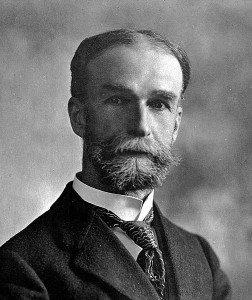Geek of the Week: Theobald Smith
By Joe Luna
Imagine that you’re a Texas rancher in 1887 and your cattle are dying of a strange fever. Not all of them, you notice, only those recently brought from the north of the country (weak yankee bovines!) Your southern cattle are otherwise fine. As you closely observe your southern cattle and the bugs that feed on them, you have the hunch that as southern bugs feed on northern cattle, that this might cause the disease. Among you cattle ranchers, you nickname these bugs “ticks.”

One slight problem: every vet and scientist who hears your theory laughs at it. Why? Because every microbiologist in the U.S. worth his culture media trained with Robert Koch in Germany, who was demonstrating the microbial basis of disease vividly in the 1880s (Anthrax in 1877, Tuberculosis in 1882, Cholera in 1883; Pasteur at this point was already legend). There were as many theories as scientists. But generally, everyone knew that microbes cause disease, not insects. Everyone, that is, except Theobald Smith.
This isn’t to say that Smith was the consummate outsider. He was a trained M.D., loved philosophy, was handy with a microscope and read all the latest papers from Germany. Though he never trained in Europe, he had immense respect for Koch’s work. But sometimes, brilliance comes from knowing when to forget your training, if only for a moment, to seek the truth outside of gleaming laboratories.
In 1889, Smith set out for Texas with F.L. Kilbourne, and set up field research as part of the Bureau of Animal Industry, a Washington based agency headed by Daniel E. Salmon. Smith immediately got to work, and started with the simplest experiment. He and Kilbourne meticulously removed every tick from a few northern cattle and showed that they never got Texas Fever! From there, everything was pure Koch – southern cattle devoid of ticks never gave northern cattle disease and ticks alone harvested from southern cattle were lethal to northern cattle. Still, Smith dug deeper. In the microscope, Smith found small “corpuscles” in the trashed red blood cells of diseased cattle. He found that northern cattle with cultured “clean” ticks never got disease and no “corpuscles” were observed. He went on to identify these corpuscles as the hemolytic parasite now called Babesia. In four years, Smith solved the puzzle, and in 1893 presented a 300-page monograph unequivocally establishing arthropods as disease vectors. He paved the way for Reed and Yellow Fever, Ross and Malaria, and his legacy is carried on at Rockefeller University (hello Professor Voshall!) But most tellingly, Smith had vindicated the lowly cattlemen’s theory, he listened when no one else would, and let the data loudly proclaim what ranchers had known all along – “No ticks, No fever!” Cattle have been treated for ticks ever since.
A sidenote: The relationship between Smith and cattle don’t stop here. Under Daniel Salmon’s direction at the BAI, the first bacterium in the genus we now call Salmonella was discovered. If you’re wondering who did the bench work to isolate this bug, you guessed right – none other than Theobald Smith.
Not gonna lie folks, I’m really craving a burger right about now.
